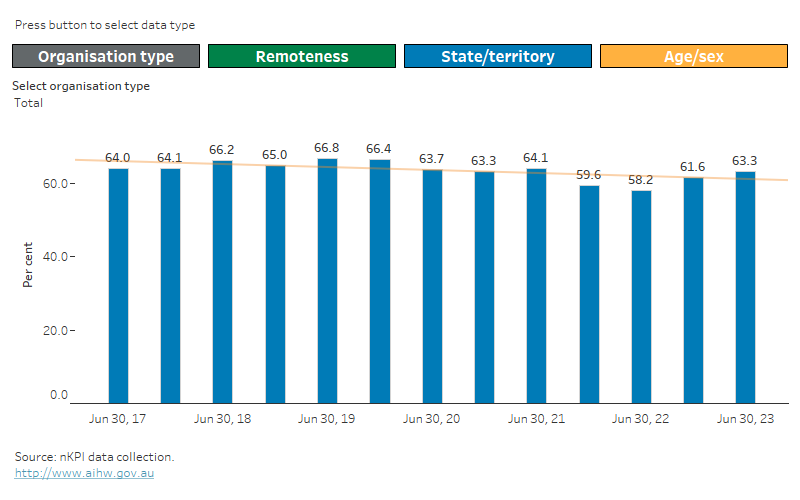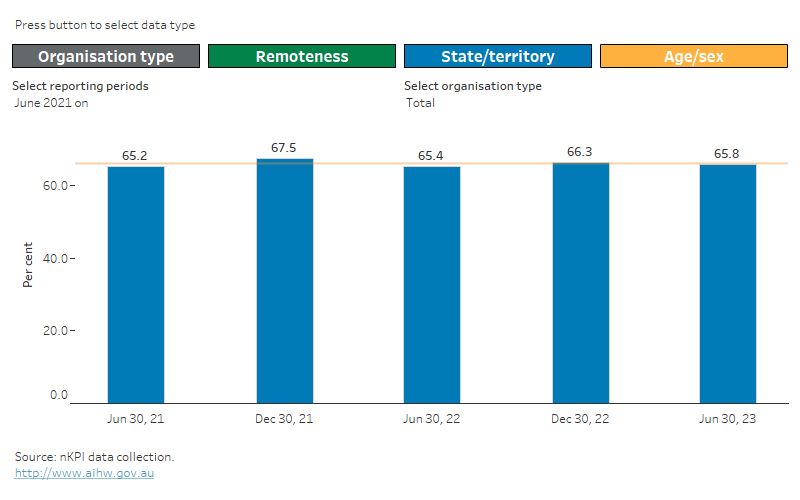Blood pressure result – type 2 diabetes (PI23 and PI24)
Indicators related to blood pressure in the national Key Performance Indicators (nKPI) collection are:
- Blood pressure result recorded – type 2 diabetes (PI23): the proportion of First Nations regular clients with type 2 diabetes whose blood pressure result was recorded within the last 6 months.
- Blood pressure result – type 2 diabetes (PI24): the proportion of First Nations regular clients with type 2 diabetes whose blood pressure result recorded within the last 6 months was less than or equal to 140/90mmHg. There have been changes to the specification of this indicator over time. For more information see Interpreting nKPI data.
PI23 and PI24 are collected for males and females in age groups from 0–4 to 65 and over, and presented here for males and females in age groups:
- under 35
- 35–44
- 45–54
- 55–64
- 65 and over.
Why blood pressure result is important
Blood pressure is the force exerted by the blood on the walls of the arteries and is written as systolic/diastolic (for example, 120/80 mmHg, stated as '120 over 80'). High blood pressure – also known as hypertension – is a risk factor for chronic conditions, including stroke, coronary heart disease, heart failure and chronic kidney disease. Managing a healthy blood pressure can reduce the risk and slow the progression of chronic conditions, such as cardiovascular disease, nephropathy, and diabetic eye disease.
People with type 2 diabetes have a higher risk of developing high blood pressure. The Royal Australian College of General Practitioners (RACGP) diabetes management guidelines note that the general target blood pressure for people with type 2 diabetes is generally less than or equal to 140/90 mmHg (RACGP 2020).
Blood pressure result recorded – type 2 diabetes (PI23)
At June 2023, 63% (or around 32,100) of First Nations regular clients with type 2 diabetes had their blood pressure result recorded within the last 6 months (Figure 1).
Figure 1: Blood pressure result recorded – type 2 diabetes – by reporting period
Blood pressure result recorded—type 2 diabetes, by reporting period
This Tableau visualisation shows the percentage of First Nations regular clients with type 2 diabetes who had their blood pressure recorded in the last 6 months, for reporting periods from June 2017 to June 2023, for either:
- type of organisation (ACCHO, non-ACCHO)
- remoteness area (Major cities, Inner regional, Outer regional, Remote, Very remote)
- state/territory (NSW/ACT, Vic, Qld, WA, SA, Tas, NT)
- age/sex (male, female with age group <35, 35–44, 45–54, 55–64, 65+).
Data supporting this visualisation are available in Excel supplementary data tables at Data.

Note: For more information, including on interpreting changes over time, see Technical notes.
Blood pressure result – type 2 diabetes (PI24)
At June 2023, 66% (or around 21,100) of First Nations regular clients with type 2 diabetes had a blood pressure result recorded within the last 6 months of less than or equal to 140/90mmHg (Figure 2).
Figure 2: Blood pressure result – type 2 diabetes – by reporting period
Blood pressure result – type 2 diabetes, by reporting period
This Tableau visualisations shows the percentage of First Nations regular clients with type 2 diabetes who had a blood pressure result of less than or equal to 140/90mmHg in the last 6 months for either:
- type of organisation (ACCHO, non-ACCHO)
- remoteness area (Major cities, Inner regional, Outer regional, Remote, Very remote)
- state/territory (NSW/ACT, Vic, Qld, WA, SA, Tas, NT)
- age/sex (male, female with age group <35, 35–44, 45–54, 55–64, 65+).
There are two different time periods:
- June 2021 to June 2023
- June 2017 to December 2020.
Data supporting this visualisation are available in Excel supplementary data tables at Data.

Notes
- In June 2021, specifications changed for this indicator and data from that point on cannot be compared with previous periods. For more information see Interpreting nKPI data.
- For more information, including on interpreting changes over time, see Technical notes.
For more information on blood pressure result see Data.
Reference
RACGP (The Royal Australian College of General Practitioners) (2020) Management of type 2 diabetes: a handbook for general practice, RACGP, accessed 1 November 2023.


